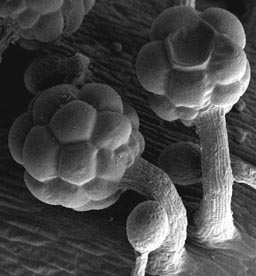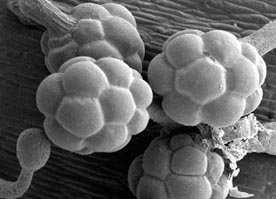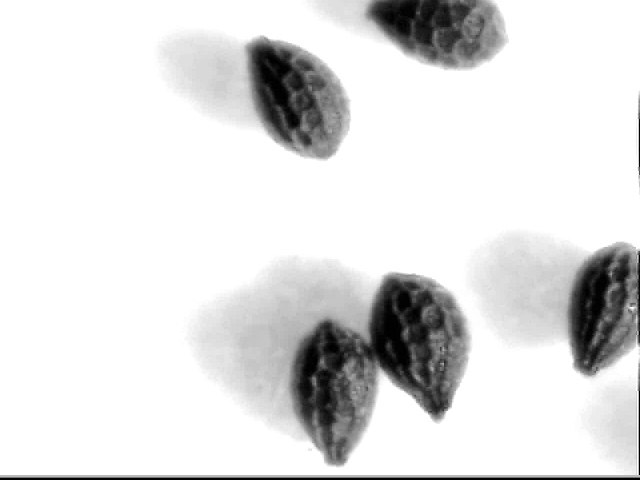|
Drosera hartmeyerorum - The Sundew with light reflecting tentacles Hartmeyer, I. & Hartmeyer, S. (2006) DAS TAUBLATT (GFP) 2006/3: 4-9 (Translation)
 Certainly closely related to Drosera indica, the Australian Drosera hartmeyerorum (described 2001 by Dr. Jan Schlauer) is unable to produce hybrids with Drosera indica varieties, and develops unique clear visible yellow emergences which developed from glue-producing tentacles into a new plant organ that functions like a reflector for bright yellow light. This can easily be tested: looking at them through a magnifier or macro-lens, switching a torch on and off that points on the plant from above. The lens-headed tentacles now reflect the light and seem to glow nearly like LEDs. As the Scanning Electron Microscope (SEM pictures by Regina Kettering, USA) show, the former glue-producing tentacle-heads changed into a sophisticated hollow structure where approximately 12 transparent giant-cells act as lenses to focus the incoming light to some solid bright yellow cells in the middle. That structure becomes visible if the plant is dried for 2 days and the giant-cells collapse. The contrasting dark red colour on the trapping leaves and bracts even amplifies that glare.  There are actually not only 5-9 emergences at the base of every trapping leaf, there are also 1-3 at the base of each bract on the flower stalks. But what are they all good for? This question caused a lot of discussions during the last 5 years. Considering the evolutionary advantage of this structure, two theories have been discussed. One possibility is a kind of mimicry known i.e. from some Passiflora species. Yellow to brownish coloured and elevated leaf-tissue looks like the eggs of a particular parasiting butterfly. Those females try to avoid competition for their own larvae and due to the egg-like tissue they will look for another egg free plant. A certain advantage for Passiflora. However, Drosera is a plant of prey and it's gluey tentacles powerful weapons also for bigger butterflys. We know that especially the annual sundews develop sophisticated strategies to catch as much prey as possible during their one and only season. It would be somehow schizophrenic for a Drosera to deter potential prey. The second theory predicts simply a more effective attraction of prey by the contrasting optical effect which guides insects deeply into the gluey plant.  Several
discussions on the phenomenon appeared on the Internet and Prof. Stephen
Williams (USA, well known for his publications on the development and
behavior of Drosera tentacles and the related Dionaea/Aldrovanda trigger
hairs) offered us at the ICPS conference in Tokyo (2002) a co-operation to
investigate the yellow emergences by SEM. Actually Regina Kettering (working
together with Steve those days) examined the plant-material that we posted
(grown from seeds, prepared with chemicals) and achieved some interesting
pictures. It becomes clear that every reflecting lens is a
single giant-cell. However, such X-ray pictures cannot display
transparency, because the plant sample needs to be prepared with a layer
of condensed metal vapour before. But combined with light microscopy the
construction becomes clear. Several
discussions on the phenomenon appeared on the Internet and Prof. Stephen
Williams (USA, well known for his publications on the development and
behavior of Drosera tentacles and the related Dionaea/Aldrovanda trigger
hairs) offered us at the ICPS conference in Tokyo (2002) a co-operation to
investigate the yellow emergences by SEM. Actually Regina Kettering (working
together with Steve those days) examined the plant-material that we posted
(grown from seeds, prepared with chemicals) and achieved some interesting
pictures. It becomes clear that every reflecting lens is a
single giant-cell. However, such X-ray pictures cannot display
transparency, because the plant sample needs to be prepared with a layer
of condensed metal vapour before. But combined with light microscopy the
construction becomes clear.Operating a spot-light for filming in our greenhouse we found just coincidentialIy that the giant cells do not only look like lenses, they even act like lenses, focussing the incoming tropical sunlight at a yellow cell-structure in the centre. The reflected yellow light is very bright, shining actually like a spotlight from a black background for insects (dark red is invisible for insect eyes which are therefore able to see UV). Looking from top of the inflorescence down the stalk, these lens-tentacles appear like a chain of runway lights (sic) for flying and jumping prey.
The discussions during the last years caused Irmgard and myself to find out even more about this puzzle. So again and again we looked at the video material that we shot at the natural growing sites to discover more details. First we found out, that other Drosera at the same sites (soil=silica sand) like D. burmannii and D. ordensis caught mainly ants. The big green, pink flowering D. indica seems to be specialised on flying insects like moths, small butterflys, flys, etc., but D. hartmeyerorum catches beside bees and midges mainly another prey: tiny baby-grasshoppers that live between the grass, frequently sitting in the upper part of the approx. 20-30 cm high grass blades. These appear alternatly with the upright pointing inflorescences of numerous D. hartmeyerorum which are scattered amongst the grass. The flower stalk of D. indica is normally full of sticky glands and mostly growing laterally away from the plant, lacking also the lens-tentacles on the bracts. Up to this point the story sounds probably trivial, but it was in fact a lot of observation time to put the puzzle together. Actually one day at our tropical greenhouse I watched a small cockroach on the upper part of a D. hartmeyerorum inflorescence creeping slowly down until it came to the first bract (above the plant) where it stopped for some seconds. Suddenly it jumped down directly into the gluey plant obviously targeting the yellow tentacles. The cockroach was a little too big to be definitly caught and escaped but suddenly a clear picture appeared inside my brain.  Once
again I looked from above down the inflorescence to the plant which was
illuminated by a 400W HQI-lamp. And realised what a baby-grasshopper
(small enough to be caught) sitting on top of the upright inflorescence
will see. Actually the yellow lens-tentacles on the bracts (number of
bracts depends on the length of the flower stalk) are shining very
bright yellow - indeed some how like runway lights - forming a "light
chain" down to the first bract. From here the last 6-10 cm of the stalk
are glabrous, but from the centre of the plant below groups of bright
yellow "spotlights" are shining up very attractively . Now the distance
from the first bract down to the plant centre seems to be ideal for the
jump of a baby-grasshopper. If it jumps down to the light it will
certainly be caught. This theory is also confirmed by the fact that
juvenile plants below a size of 3 or 4 cm develop non or only 1-2
yellow emergences, plausible because they are too small to catch those
particular grasshoppers (it seems to be more than only coincidence that
2001 as well as 1995 - on different sites - grasshoppers were caught in
the majority of cases). If the trapping leaves produce more
lens-tentacles for the first time it needs only several days, maybe 2
weeks until a first upright growing inflorescence appears. Once
again I looked from above down the inflorescence to the plant which was
illuminated by a 400W HQI-lamp. And realised what a baby-grasshopper
(small enough to be caught) sitting on top of the upright inflorescence
will see. Actually the yellow lens-tentacles on the bracts (number of
bracts depends on the length of the flower stalk) are shining very
bright yellow - indeed some how like runway lights - forming a "light
chain" down to the first bract. From here the last 6-10 cm of the stalk
are glabrous, but from the centre of the plant below groups of bright
yellow "spotlights" are shining up very attractively . Now the distance
from the first bract down to the plant centre seems to be ideal for the
jump of a baby-grasshopper. If it jumps down to the light it will
certainly be caught. This theory is also confirmed by the fact that
juvenile plants below a size of 3 or 4 cm develop non or only 1-2
yellow emergences, plausible because they are too small to catch those
particular grasshoppers (it seems to be more than only coincidence that
2001 as well as 1995 - on different sites - grasshoppers were caught in
the majority of cases). If the trapping leaves produce more
lens-tentacles for the first time it needs only several days, maybe 2
weeks until a first upright growing inflorescence appears.The seeds are minute - even for the whole genus - showing a typical honeycomb structure. After germination seedlings are only one millimetre across but they are easily visible due to their typical dark red coloration. Now you face your first problem: they will only grow if they get protein! If you cannot provide springtails or other minute insects, you must feed them! We use a tweezers with magnifier and feed crushed fishfood flocks which is very effectiv. Without protein the plants will soon rot. If fed approx. all 10 days with appropriate portions they double their size during this time. Of course, this plant grows very quickly. In their tropical habitat they germinate about January to February and end of April we found them in full blossom. The seeds ripen within approx. 2 or 3 weeks and while the inflorescence is still growing on with numerous flowers the first seedpots open and the minute seeds are blown out and scattered around by the wind. This rapid growing and fruiting needs a lot of energy = prey which due to the nutrient poor silica sand can only be achieved if the trapping mechanism is very effective.  Summarising the meanwhile known
features of the annual D. hartmeyerorum it looks like a sophisticated
trapping strategy using light effects for attraction. If this is really an
adaption to catch specifically baby-grasshoppers - which are indeed very
frequent in the area during the growing season - should be examined at
different natural growing sites, counting lots of prey on a statistical
relevant amount of plants. The still discussed theory that the
lens-tentacles are developed for parasite egg mimicry to deter particular
butterflies seems to be more and more unlikely. However, the
unique runway lights make it very easy to identify this species and to
distinguish it from D. indica. Summarising the meanwhile known
features of the annual D. hartmeyerorum it looks like a sophisticated
trapping strategy using light effects for attraction. If this is really an
adaption to catch specifically baby-grasshoppers - which are indeed very
frequent in the area during the growing season - should be examined at
different natural growing sites, counting lots of prey on a statistical
relevant amount of plants. The still discussed theory that the
lens-tentacles are developed for parasite egg mimicry to deter particular
butterflies seems to be more and more unlikely. However, the
unique runway lights make it very easy to identify this species and to
distinguish it from D. indica.Thank you very much to Barry Rice, Stephen Williams and Regina Kettering for the permission to show their great pictures with our publications.
References: Hartmeyer, I. & Hartmeyer, S., Observations on a New Drosera Species in the Ord River Region (Australia) (2001) Carnivores Plant Newsletter (ICPS) 30/4:107 - 110 Hartmeyer, I. & Hartmeyer, S., Reiseziel Insektivoren (englischer Titel: Beautiful and Hungry – Carnivorous Plants Part 2), Video/DVD private Produktion 1995 Hartmeyer, I. & Hartmeyer, S., FLEISCHIMANIA (deutsch und englisch), Video/DVD private Produktion 2001 Hartmeyer, I. & Hartmeyer, S., The International Carnivorous Plant Conference Tokyo, Video/DVD private Produktion 2002 Hartmeyer, I. & Hartmeyer, S., Quer durch’s Karnivorenbeet (englischer Titel: A Hunting Veggies Cocktail), DVD private Produktion 2004 Hartmeyer, I. & Hartmeyer, S., DROSERA: Schnelltentakel und Landescheinwerfer (englischer Titel: DROSERA: Snap-Tentacles and Runway Lights, DVD private Produktion 2006 Schlauer, J., Drosera hartmeyerorum spec. nov. (Droseraceae), a New Sundew in sect. Arachnopus from North Australia. (2001) Carnivores Plant Newsletter (ICPS), 30/4: 104 - 106 Williams, S.E., Pickard, B.G., Connections and Barriers between Cells of Drosera Tentacles in Relation to Their Electrophysiology, Planta (Berl.) 116, 1-16 (1974) Williams, S.E., Comparative Sensory Physiology of the Droseraceae - The Evolution of a Plant Sensory System, Proceedings of the American Philosophical Society, Vol. 120 No. 3, June 1976 Williams, S.E., Pickard, B.G., The Role of Action Potentials in the Control of Capture Movements of Drosera and Dionaea, Plant Growth Substances 1979, Springer Verlag Berlin-Heidelberg-New York Williams, S.E., Albert, V.A., Chase, M.W., Relationships of Droseraceae: A Cladistic Analysis of RBCL Sequence and Morphological Data, American Journal of Botany, 81(8): 1027-1037, 1994 |